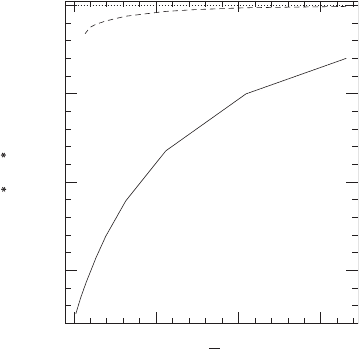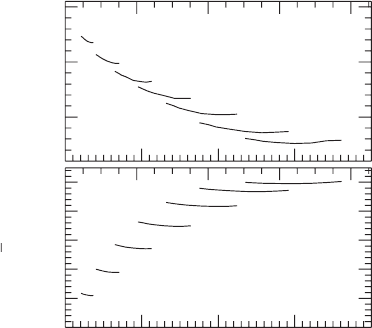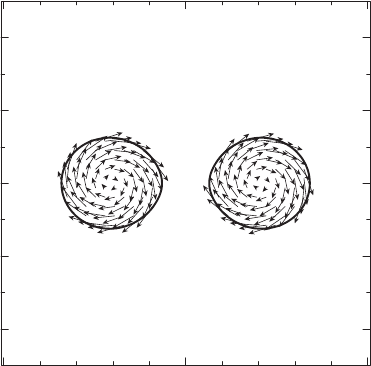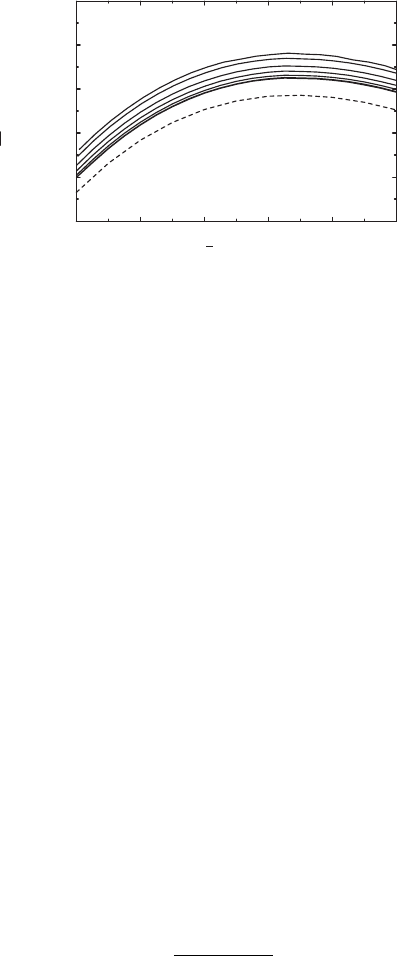Baumgarte T., Shapiro S. Numerical Relativity. Solving Einstein’s Equations on the Computer
Подождите немного. Документ загружается.


15.2 Corotational binaries 521
0
−0.05
−0.15
2 2.5 3
d
3.5
−0.1
∆ r
max
/
r
max
∞
Figure 15.3 The relative change in the maximum density ρ
∗
max
/ρ
∗∞
max
as a function of the separation
¯
d between
the locations of the maximum densities in an equal-mass, n = 1 polytropic binary with companions of rest-mass
¯
M
0
= 0.18 (close to the maximum allowed mass for static stars). The solid line marks the changes in the density
for corotational binaries, and the dashed line for irrotational binaries. The dotted lines marks ρ
∗
max
= 0. This
graph shows that the central density decreases with decreasing binaries for both corotational and irrotational
binaries. Similar results hold for binaries of different masses and polytropic indices, and also for unequal-mass
binaries. [After Taniguchi and Gourgoulhon (2002).]
should reduce the density inside a star.
16
As a consequence, the “star-crushing” effect was
met with great skepticism in the community.
Our argument above, based on Figure 15.2, also suggests that the central density should
decrease, and not increase, with decreasing binary separation. However, this argument
only holds for corotational binaries. At small binary separations corotational binaries have
to spin very fast to keep up with the orbit. This spin by itself leads to a flattening of
the star and hence may lead to a reduction in the central density, even in isolated stars.
Moreover, corotation is not maintained during binary inspiral for realistic neutron stars,
as we discussed in Section 15.1. The more relevant question is therefore how the central
density behaves in irrotational binaries. Anticipating findings from Section 15.3 we show
in Figure 15.3 results for irrotational quasiequilibrium binaries, as well as more accurate
results for corotational, binaries. This plot demonstrates that, while the effect is indeed
much smaller for irrotational binaries than for corotational binaries, the central density
decreases with decreasing binary separation in both cases.
Ultimately, the original controversy was resolved when a mistake was found in the cal-
culations of Wilson and Mathews (1995)andWilson et al. (1996)(seeFlanagan 1999).
Correcting this mistake reduced the size of the reported effect dramatically.
17
More signif-
icantly, no sign of a “crushing instability” has been observed in any other post-Newtonian
16
See Rasio and Shapiro (1999) for a review and references.
17
Mathews and Wilson (2000).

522 Chapter 15 Binary neutron star initial data
0 0.01 0.02
M
0
Ω
M
1.5
f
[Hz]
0.2
0.2
0.03 0.04
0
0.05
0
0
0.05
0.05
200 400
n = 1.0
(M −M
∞
) /M
0
600 800
0.04
0.03
0.02
J
0.01
−0.005
−0.01
Figure 15.4 The binding energy and angular momentum as functions of orbital angular velocity for several
different values of the rest mass
¯
M
0
. The curves are labeled by the compaction (M/R)
∞
that the stars would have
at infinite binary separation, starting with 0.05 and increasing in steps of 0.0025 up to 0.2. The maximum
compaction of a stable, isolated, nonrotating n = 1 polytrope is 0.217. The upper label gives the orbital frequency
for stars with a rest mass of 1.5M
.[FromBaumgarte et al. (1998a).]
or fully relativistic simulation of neutron star inspiral and merger
18
as we will discuss in
Chapter 16, although no theorem has been proven to completely rule out the possibility.
19
As we discussed in Chapter 12.1, the innermost stable circular orbit (ISCO) marks a
transition from a slow, quasistationary inspiral to a rapid plunge and merger. While this
transition may not be particularly abrupt, crossing the the ISCO will mark a transition in
the emitted gravitational waveform away from a quasiperiodic chirp signal (see Chapter
16). Locating the ISCO and the orbital frequency to which it corresponds are therefore
important goals when constructing quasiequilibrium sequences of binary neutron stars.
We can identify the ISCO by locating the minimum of the total ADM energy M
ADM
along an evolutionary sequence of constant rest-mass M
0
(see Chapter 12.1). As discussed
in Chapter 12 in conjunction with equation (12.112),
dM
ADM
= dJ, (15.62)
a minimum in the energy should coincide with a minimum in the angular momentum. In
Figure 15.4 we show some numerical results obtained on a coarse grid for the fractional
binding energy (M
ADM
− M
∞
ADM
)/M
0
and the angular momentum
¯
J for sequences of
18
Such an effect can occur in binaries consisting of collisionless clusters; Shapiro (1998); Duez et al. (1999).
19
See, e.g., Favata (2006).

15.3 Irrotational binaries 523
Table 15.1 The orbital angular velocity , angular momentum J and ADM mass
¯
M
ISCO
at the
ISCO, for corotating, equal mass, binary neutron stars with polytropic index n = 1. We tabulate
the rest-mass
¯
M
0
, the ADM mass
¯
M
∞
and the compaction (M/R)
∞
each star would have in
isolation (where R is the areal radius), as well as the angular velocity M
0
, angular momentum
J
tot
/M
2
tot
(where “tot” means total ADM value) and ADM mass
¯
M
ISCO
≡ M
tot
/2attheISCO.
For this EOS the maximum rest mass in isolation is
¯
M
max
0
= 0.180. [After Taniguchi and
Gourgoulhon (2002).]
¯
M
0
¯
M
∞
(M/R)
∞
M
0
ISCO
(J
tot
/M
2
tot
)
ISCO
¯
M
ISCO
0.130 0.122 0.12 0.0139 1.136 0.1213
0.146 0.136 0.14 0.0175 1.075 0.1350
0.160 0.148 0.16 0.0217 1.028 0.1464
0.171 0.157 0.18 0.0253 0.994 0.1550
constant rest mass
¯
M
0
. In the definition of the binding energy, M
∞
ADM
denotes the ADM
mass that this star would have at infinite binary separation. We plot these quantities vs.
the orbital frequency instead of binary separation, because the former is a gauge-invariant
quantity while the latter is not.
20
Figure 15.4 suggests that the minima in the binding energy
(and hence the ADM mass) do indeed coincide with those of the angular momentum, and
thereby identify the ISCO.
In Table 15.1 we list the angular velocity M
0
, the total angular momentum J
tot
/M
2
tot
(where M
tot
is the total ADM mass of the binary system), and the individual ADM mass
M
ISCO
≡ M
tot
/2 at the ISCO for different values of the stellar rest mass M
0
for equal-
mass, n = 1 polytropes. As it turns out, only stars with sufficiently stiff equations of state
(n
<
∼
1.0) encounter an ISCO before they touch, which is in qualitative agreement with
Newtonian results.
21
Stars with softer equations of state are more centrally condensed and
have more extended envelopes, so that they come into contact and merge before reaching
an ISCO.
As we discussed in Section 15.1 above, the assumption of corotation is very unrealistic,
since it requires an unrealistically large viscosity. To obtain results that are of greater
astrophysical relevance than those found in this section, we must consider irrotational
binaries.
15.3 Irrotational binaries
We can find a set of equations that governs irrotational binaries in close analogy to our
Newtonian treatment in Section 15.1.1.
22
In general relativity, the vorticity tensor ω
ab
can
20
Also, the observed gravitational wave spectrum is dominated by mass quadrupole emission at frequency f
GW
= /π.
21
See, e.g., Rasio and Shapiro (1999) for a review and references.
22
The first relativistic formalism for irrotational binaries in quasiequilibrium was presented in Bonazzola et al. (1997).
Subsequently, other approaches were developed by Asada (1998), Teukolsky (1998)andShibata (1998). Gourgoulhon
(1998) demonstrated that all of these formulations are equivalent. The derivation here follows that of Shibata (1998).

524 Chapter 15 Binary neutron star initial data
be defined as
ω
ab
≡ P
c
a
P
d
b
(
∇
d
(hu
c
) −∇
c
(hu
d
)
)
, (15.63)
where P
b
a
= g
b
a
+ u
a
u
b
is the projection operator with respect to the fluids’s 4-velocity
u
a
(equation 5.67). For irrotational binaries the vorticity must vanish,
ω
ab
= 0, (15.64)
which is equivalent to the Newtonian condition (15.27). For this to be the case, the quantity
hu
a
must be the gradient of a velocity (scalar) potential ,
hu
a
=∇
a
; (15.65)
cf. (15.28).
Exercise 15.6 Show that with equation (15.65) the continuity equation (15.2)
reduces to
∇
a
ρ
0
h
∇
a
= 0, (15.66)
while the Euler equation (15.34) is satisfied identically.
Exercise 15.7 (a) Use the Euler equation (15.34) to show that ω
ab
can be written
ω
ab
=∇
b
(hu
a
) −∇
a
(hu
b
). (15.67)
(b) Evaluate equation (5.59) to show that for irrotational flow in an isentropic fluid
the circulation satisfies
C = 0.
With the definition (15.36), the spatial projection of equation (15.65) becomes
ˆ
u
i
= D
i
. (15.68)
In the Euler equation (15.42) this result now eliminates the second term, so that we can
integrate the first term once to find
h
u
t
+
ˆ
u
i
V
i
= C, (15.69)
where C is again a constant of integration.
It is now convenient to introduce a rotational shift vector
B
a
= β
a
+ k
a
, (15.70)
where k
a
is given by equation (15.11)ask
a
= ξ
a
hel
− t
a
. From equation (2.98)wehave
t
a
= αn
a
+ β
a
, so that we can write B
a
as
B
a
= ξ
a
hel
− αn
a
. (15.71)
We now solve equation (15.35)forV
a
, substitute equation (15.71)forξ
a
hel
, take the spatial
projection (to eliminate the αn
a
term), substitute equation (15.68)foru
i
, and obtain

15.3 Irrotational binaries 525
finally
V
i
=
1
u
t
h
D
i
− B
i
. (15.72)
As we did for corotational binaries, we now use the normalization u
a
u
a
=−1 to express
u
t
in terms of the spatial components of the 4-velocity. Substituting equation (15.68) into
(15.47) yields
αu
t
=
1 + h
−2
D
i
D
i
1/2
. (15.73)
We next combine equations (15.69), (15.72) and (15.73)tofind
αu
t
=
1
αh
C + B
i
D
i
. (15.74)
We digress to note an interesting result derived in exercise 15.8.
Exercise 15.8 Use L
ξ
hel
(hu
a
) = 0 to show that
L
ξ
hel
= ξ
a
∇
a
=−C
(15.75)
where C
is a constant.
Naively, we might have expected that the Lie derivative of along the Killing vector
ξ
hel
vanishes. However, is only a potential and not a measurable (physical) quantity. Only
the gradient of , ∇
a
= hu
a
, is measurable, and therefore only for the gradient can we
impose the Lie derivative along ξ
hel
to vanish.
23
As we have found in exercise 15.8, this
introduces a constant of integration when we evaluate the Lie derivative of itself. We
can now use the result (15.75) to provide an alternative derivation of equation (15.74)(see
exercise 15.9).
Exercise 15.9 Replace n
a
in hαu
t
=−hn
a
u
a
=−n
a
∇
a
with the help of equa-
tion (15.71) to rederive equation (15.74).
We can finally combine equations (15.73) and (15.74)tofind
h
2
=
1
α
2
(C + B
i
D
i
)
2
− D
i
D
i
. (15.76)
As in the Newtonian derivation, the integrated Euler equation (15.69) furnishes an algebraic
expression for the enthalpy h. We could have left this equation in the form (15.69), but
since h also appears in V
i
we have taken a few more steps to isolate h in equation (15.76).
We still need an equation for the velocity potential , which we can find from the
continuity equation (15.43). Inserting (15.72)into(15.43) we obtain
D
i
(αρ
0
h
−1
D
i
) − D
i
(αu
t
ρ
0
B
i
) = 0. (15.77)
23
See also Teukolsky (1998), who shows formally that L
ξ
hel
hu
a
= 0 = L
ξ
hel
d =
dL
ξ
hel
(see exercise A.3), which
implies equation (15.75).

526 Chapter 15 Binary neutron star initial data
To eliminate u
t
we can now insert equation (15.74) and find, just like in the Newtonian
case, an elliptic equation for the velocity potential ,
D
i
D
i
− D
i
C + B
j
D
j
α
2
B
i
=
C + B
j
D
j
α
2
B
i
− D
i
D
i
ln
αρ
0
h
.
(15.78)
Equations (15.76) and (15.78) now provide two equations for the two fluid variables h
and . Equation (15.78) is an elliptic equation and hence needs to be supplemented
with boundary conditions for on the stellar surface. Since ρ
0
vanishes there, regularity
requires
C + B
j
D
j
α
2
B
i
− D
i
D
i
ρ
0
surface
= 0. (15.79)
This is again a Neumann boundary condition. Just like its Newtonian equivalent (15.33)
this condition enforces the fluid flow to be tangent to the surface.
Exercise 15.10 Show that in the Newtonian limit equations (15.76), (15.78)and
(15.79) reduce to the Newtonian equations (15.31), (15.32)and(15.33).
In most applications to date, the matter equations (15.76) and (15.78) have been solved
together with the conformal thin-sandwich equations (3.109)–(3.112)forthelapseα,the
shift β
i
and the conformal factor ψ. Constructing irrotational binaries is much more
involved than constructing corotational binaries. By contrast with corotational binaries,
where only one algebraic equation (15.46) has to be solved for the enthalpy, we now have
to solve the enthalpy equation (15.76) together with the elliptic equation (15.78) for the
velocity potential , subject to the boundary condition (15.79) on the surface of the star.
The latter adds another complication, since the location of the surface is not known a priori.
Bonazzola et al. (1999a)andGourgoulhon et al. (2001) solved this problem with the
help of a multidomain, spectral method that covers the entire computational domain with
several patches of coordinate systems. In particular, the interiors of the stars are covered
with spherical-type coordinate systems, which are constructed so that the surface of the
star lies at a constant value of the radial coordinate. Such coordinate systems are called
“surface-fitting” coordinates, and are very well suited for imposing the boundary condition
(15.79). A similar algorithm, based on Newtonian simulations of irrotational neutron star
binaries,
24
has been used by Ury
¯
u et al. (2000).
25
As a brief, technical detour, we point out why it is natural for these calculations in
spherical polar coordinate systems to use two computational domains, each one centered
on one of the binary companions. Consider an equation of the form
¯
D
2
φ = RHS, (15.80)
24
Ury
¯
u and Eriguchi (1999).
25
See also Ury
¯
u and Eriguchi (2000).

15.3 Irrotational binaries 527
0
x [km]
y [km]
50
4020−20−40
−50
0
Figure 15.5 The internal velocity field with respect to the corotating frame in the orbital plane for identical stars
of rest mass M
0
= 1.625M
at a coordinate separation of 41 km. The binary stars are irrotational and
constructed from an n = 1 polytropic EOS with K = 1.8 ×10
−2
Jm
3
/kg
2
. The thick lines mark the stellar
surfaces. [From Gourgoulhon et al. (2001).]
where RHS symbolizes some potentially nonlinear source terms on the right hand side.
We can choose to solve this equation by splitting it into the two equations
¯
D
2
φ
1
= RHS
1
,
¯
D
2
φ
2
= RHS
2
,
(15.81)
where φ = φ
1
+ φ
2
and RHS = RHS
1
+ RHS
2
, and where each equation is now associated
with one of the two stars. The two equations in (15.81) can then be solved on two separate
computational domains, each one centered on one star. Clearly, the separation of the source
terms RHS into the two parts RHS
1
and RHS
2
is far from unique. One guiding principle
is to move those parts of RHS that are large in the neighborhood of star 1 into RHS
1
,
and similarly for the other star. Another principle is that each of the source terms should
asymptotically coincide with those for the corresponding isolated star when the binary
separation is large.
We show a typical binary configuration and its internal velocity field in Figure 15.5.As
we did for corotational binaries, we can determine the maximum allowed mass of neutron
stars in irrotational binaries by first finding the mass as a function of central density for
fixed separation, and then varying the separation. In Figure 15.6 we show results of Ury
¯
u
et al. (2000), which demonstrate that, as in corotational binaries, the maximum mass
increases with decreasing separation. However, by comparing with Figure 15.2, we note
that the increase in maximum mass is smaller for irrotational binaries than for corotational

528 Chapter 15 Binary neutron star initial data
0.25 0.27 0.29 0.31 0.33 0.35
(ρ
0,
max
)
0.177
0.178
0.179
0.18
0.181
0.182
M
0
Figure 15.6 The rest mass
¯
M
0
as a function of maximum density ¯ρ
0
for separations
¯
d = 1.3125, 1.375,
1.5, 1.625, 1.75, 1.875 and 2 (thick lines running from top to bottom) of irrotational, binary neutron stars
constructed from an n = 1 polytropic EOS. The dashed line is the Oppenheimer–Volkoff result. [From Ury
¯
u
et al. (2000).]
binaries.
26
This result is not surprising, since neutron stars in corotational binaries are
spinning with respect to the inertial frame at rest with respect to the binary center. This
spin by itself increases the maximum mass of neutron stars.
27
It is also evident from
Figures 15.6 and 15.2 that, while the density along evolutionary sequences of irrotational
binaries of constant rest mass
¯
M
0
decreases with decreasing separation, the decrease is
less than that for corotational binaries, which we had already anticipated in Figure 15.3.
As we have seen in Section 15.2, evolutionary sequences of corotational binaries typ-
ically end either at the ISCO or at contact. Irrotational sequences, on the other hand,
typically end when a cusp forms on the stellar surface, prior to reaching the ISCO or
contact.
28
Such a cusp forms when the stellar surface reaches an inner Lagrange point, so
that matter can start flowing from one star to its companion.
A potential disadvantage of using spectral methods for constructing these binaries is
that the appearance of such a cusp on the stellar surface leads to Gibbs phenomena and
hence decreasing accuracy. Typically, sequences constructed with spectral methods must
therefore terminate shortly before the appearance of a cusp. To identify cusp formation,
many authors
29
introduce a “mass-shedding indicator” χ, defined as the ratio between the
radial derivative of the specific enthalpy h on the neutron star equator at the point nearest
to the companion to the radial derivative at the pole,
χ ≡
∂
r
(ln h)
|
eq
∂
r
(ln h)
|
pole
. (15.82)
26
This result is especially evident taking into account the coarse resolution used by Baumgarte et al. (1998a), which
underestimate the masses in Figure 15.2.
27
See, e.g., Cook et al. (1994b) as well as Chapter 14.
28
Bonazzola et al. (1999a); Ury
¯
u and Eriguchi (2000); Ury
¯
u et al. (2000).
29
See, e.g., Gourgoulhon et al. (2001).

15.3 Irrotational binaries 529
Table 15.2 The orbital angular velocity , angular momentum J and the ADM mass
¯
M at cusp
formation, for irrotational, equal-mass, binary neutron stars with polytropic index n = 1. We tabulate the
individual rest mass
¯
M
0
, the ADM mass
¯
M
∞
and the compaction (M/R)
∞
each star would have in
isolation (where R is the areal radius), as well as the angular velocity M
0
, the angular momentum
J
tot
/M
2
tot
(where “tot” means total ADM value) and the ADM mass
¯
M
CUSP
= M
tot
/2 at cusp formation.
For this EOS, the maximum rest mass in isolation is
¯
M
max
0
= 0.180. [After Taniguchi and Gourgoulhon
(2002).]
¯
M
0
¯
M
∞
(M/R)
∞
M
0
CUSP
(J
tot
/M
2
tot
)
CUSP
¯
M
CUSP
0.130 0.122 0.12 0.0142 0.997 0.1211
0.146 0.136 0.14 0.0181 0.947 0.1347
0.160 0.148 0.16 0.0222 0.910 0.1460
0.171 0.157 0.18 0.0265 0.881 0.1546
This indicator is identically one for a spherical star and falls to zero at the appearance of a
cusp. We can then tabulate χ as a function of binary separation, or orbital angular velocity,
and extrapolate to χ = 0 to identify the onset of cusp formation.
Ury
¯
u et al. (2000) find that equal-mass, irrotational binaries reach an ISCO before a cusp
appears only for very stiff equations of state (n
<
∼
2/3), while binaries with softer equations
of state form a cusp first. In Table 15.2 we list some parameters for irrotational, equal-mass
n = 1 binaries at cusp formation. Comparing with the corresponding ISCO parameters
of corotational binaries in Table 15.1, we note that the cusp and ISCO occur at quite
similar frequencies. The corotational binaries have more angular momentum, because the
individual stars carry a spin in addition to the orbital angular momentum of the binary. We
also find that the binding energy (
¯
M −
¯
M
∞
)/
¯
M
0
of corotational binaries is slightly larger
than for irrotational binaries. This is because the ADM mass
¯
M of the former include the
additional spin kinetic energies of the individual stars.
30
For additional numerical results,
including models for different equations of state and unequal-mass binaries, we refer the
reader to the literature.
31
In all of the above calculations the matter equations (15.76), (15.78) and (15.79)have
been solved together with the conformal thin-sandwich formalism of Chapter 3.3 for the
gravitational fields, as summarized in Box 3.3. However, it is not clear that this formalism
is the best possible approach for constructing quasiequilibrium binaries. In particular,
this approach makes an ad hoc choice for the conformally-related background metric ¯γ
ij
,
which may or may not lead to the best approximation of quasiequilibrium. Several authors
have therefore suggested alternative methods that may produce more accurate models of
compact binaries in quasiequilibrium.
32
30
See also the discussion in Duez et al. (2002).
31
See, e.g., Taniguchi and Gourgoulhon (2002, 2003).
32
See, e.g., Blackburn and Detweiler (1992); Andrade et al. (2004); Shibata et al. (2004); Friedman and Ury
¯
u (2006)
and references therein.
530 Chapter 15 Binary neutron star initial data
One of these alternative approaches is the “waveless” approximation of Shibata et al.
(2004) that we discussed briefly in Chapter 3.4. Ury
¯
u et al. (2006) implemented this
scheme for binary neutron stars. As expected, for stars with small compaction they obtain
results that are very similar to those found with the conformal thin-sandwich approach
assuming conformal flatness. For stars with a larger compaction, however, their results
show some deviation from both the conformally flat models as well as third post-Newtonian
(3PN) point-mass calculations. For stars with a compaction (M/R)
∞
= 0.17, at a binary
separation at which the coordinate distance from the orbital center to the geometric center
of each star is 1.75R
∞
, the conformally related metric, for example, deviates from a flat
metric by about 1%. The deviations in the binding energy are comparable. To establish
whether or not these models are closer to quasiequilibrium than the conformally flat
models presumably requires a fully dynamical hydrodynamic simulation. We describe
such simulations for binary neutron stars in Chapter 16.
15.4 Quasiadiabatic inspiral sequences
In the previous sections we have discussed how we can construct individual models of
binary neutron stars in circular orbit at arbitrary binary separations. We have also mentioned
that we can “stitch” together models of constant rest mass M
0
to build evolutionary inspiral
sequences. In this section we will describe how such a “quasiadiabatic” approach can be
used to calculate the gravitational wave signal from the late inspiral phase, prior to plunge
and merger.
33
We start by approximating the binary orbit outside the ISCO as circular, and by treating
the orbital decay as a small correction. For each binary separation we can then find the
matter distribution using the quasiequilibrium methods of the previous sections. Next we
need to find the gravitational wave signal and luminosity at a given binary separation.
As a crude approximation we could simply use the quadrupole formula, equation (9.37),
but we can do better than that. We can substitute the quasiequilibrium matter profiles that
we obtained above as source terms in the Einstein field equations, and then evolve these
equations. In effect, we are performing a relativistic hydrodynamics simulation without
having to resolve the hydrodynamic equations, given that the matter is in near equilibrium.
This approach is sometimes referred to as “hydro-without-hydro”.
34
Evolving the gravitational fields for the given binary matter distribution, we can then
read off the gravitational waveform and luminosity, and hence the rate at which the binary
loses energy at a given separation r . Combining this luminosity dM
ADM
/dt =−L
GW
with
the derivative of the ADM mass with respect to separation r along a quasiequilibrium
33
Similar ideas have been suggested as possible solutions to the “intermediate compact binary problem” that may arise
if (point-mass) post-Newtonian techniques, which are favored for the modeling of the adiabatic inspiral phase, break
down at too large a binary separation for fully dynamical numerical relativity simulations to track the entire remaining
inspiral. Bridging the resulting gap between post-Newtonian and numerical relativity methods might then require some
“quasiadiabatic” technique similar to the one sketched in this section to treat the full inspiral phase (see Brady et al.
(1998) and Duez et al. 2002).
34
See Baumgarte et al. (1999).
